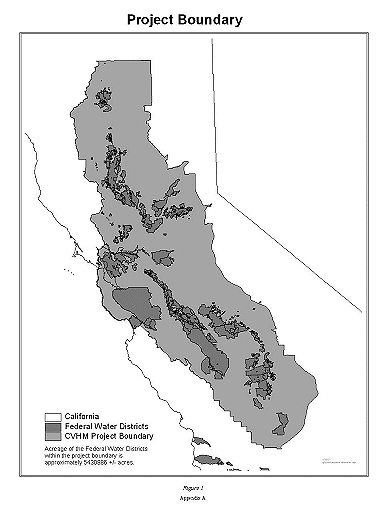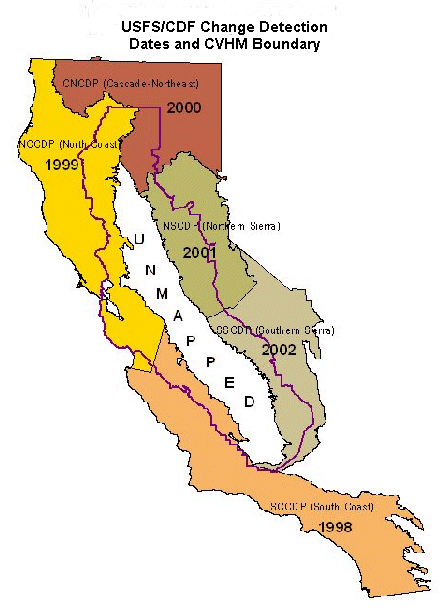
The intent of the Central Valley Habitat Monitoring program is to perform long-term monitoring for changes in land cover and habitat in the Central Valley. This is in conjunction with coordination with the State and Federal land cover monitoring and mapping programs. Data from this program will be part of a multi-agency effort to create contiguous vegetation and land cover data for the state of California vegetation and land cover data set.
Background
A historical synopsis of the Central Valley Project and its relation
the the Central Valley Habitat Monitoring Program - The Central Valley
Project (CVP) is a system of 20 dams and reservoirs, canals, power
plants, and other facilities located mainly in California's Sacramento
and San Joaquin Valleys. The CVP is operated by the Bureau of Reclamation.
The purpose of the Central Valley Habitat Monitoring Program (CVHM)
is to help meet analytical requirements for the CVP Biological Assessments
and Contract Renewal Biological Opinions. These biological assessments
and opinions are intended to insure that the existing operation of the
CVP and implementation of the Central Valley Project Improvement Act (CVPIA
) occurs in a manner compatible with the continued existence and recovery
of listed or proposed species, or designated or proposed critical habitat.
The Central Valley Project Improvement Act's purpose is to mandate changes
in the management of the CVP, particularly for the protection, restoration
and enhancement of fish and wildlife.
The Development and Execution of CVHM
The requirement of a strategy to identify and map existing and potential habitat and track changes in land use categories is what led USBR and USFWS to develop the Central Valley Habitat Monitoring Program. The proposed program will monitor change data every 5 to 10 years to help meet analytical requirements for the CVP Biological Assessments and Contract Renewal Biological Opinions. Consistent mapping standards, analytical procedures, and habitat classifications are being developed to produce products that will meet requirements of the Biological Opinion. This Biological Opinion requires USBR to identify lands within the water contract service areas that receive Federal water and are actively farmed. It also requires the development of a comprehensive strategy to identify and map existing and potential habitat and track changes in land use categories over time. These categories include vegetation and associated habitat, as well as acreage devoted to agricultural production.
Incorporation of methods from the U.S. Forest Service (USFS) and California Department of Fire and Forestry's (CDF) are used where possible to ensure compatibility with other statewide mapping and change detection programs. Standards are also being developed with other agencies through subcommittee meetings of the Biodiversity Council's Science Coordination Committee.
This paper will describe the process of developing a workplan for change detection and future monitoring by defining the organization and strategy of the project.
Process of Developing a Workplan
The Central Valley Habitat Monitoring Program began as a joint effort
between the U.S. Fish and Wildlife Service and the U.S. Bureau of Reclamation
in January 2000. A technical team consisting of specialists in GIS,
Remote Sensing and biology from both agencies, was formed. Often
times during the development of a project the request is nebulous. Without
fully understanding the scope, complexity and objectives of the project,
requests are made with unrealistic time frames and desires. One of
the greatest challenges is to clearly define what is needed to satisfy
the project objectives.
Skilled GIS/Remote Sensing personnel spent time with the all participants
discerning actual needs and objectives. During CVHM's embryonic stages,
skilled GIS/RS personnel spent time with management and technical personnel
to clearly define requirements and realistic time frames. From this information,
the team went to work identifying major tasks and developing a project
workplan while performing preliminary project work. The first six
months were spent developing the CVHM work plan. This work plan is the
foundation upon which the monitoring program is built.
After completion of the preliminary workplan, the next step was to develop an awareness of the magnitude and complex scope of the project among key personnel within both agencies. The team developed a comprehensive presentation that outlined the purpose of the project, defined the project area and educated key personnel on the technical aspects of change detection using remote sensing techniques. The result was a deeper understanding of the magnitude of the mapping proposal and the teams efforts to develop a quality product. These meetings incouraged the acceptance of a realistic timeline and allocation of staff. Presentations also provided an outreach forum for further clarifying project goals and developing partnerships with a variety of interested parties.Phase I entails the development of a land cover database for 1993 using existing data sets. Phase II consists of processing the 1993 satellite imagery with 2000 satellite imagery to delineate areas of spectral change between the two dates. Phase III will focus on areas of spectral change delineated in Phase II. This will consist of necessary field sampling and acquisitions of aerial photography to determine the nature and cause of the spectral change (i.e. habitat change due to urban expansion). The USBR will conduct this verification process within the Federal Water Districts and is seeking cooperation and support from other agencies in verifying the remaining areas within the project boundary.
Execution of the Plan
The CVHM boundary encompasses 125,206,151 sq. kilometers. Within that
boundary are CVP water service areas which are responsible for distributing
water throughout the Central Valley. This area is equivalent to 21978 sq.
kilometers. The first priority is to
identify land use and habitat changes within CVP water service areas, however,
spectral change data is being generated for the entire area (fig. 1).
Partnerships are being sought to help with verification of change areas
outside the CVP water service areas.
The overall monitoring program boundary with acreage estimates is shown
in Figure 1.
Phase I
This phase consists of the creation of a land cover database
representative of land cover and vegetation conditions in 1993. Best available
existing land cover data and satellite imagery for this time are used to
create this database. The FWS and USBR have agreed that classification
types represented in the California Department of Fish & Game / Ducks
Unlimited database will be used for wetland types, and WHR (Wildlife Habitat
Relationships) classification types will be used for upland types. The
USBR and FWS are evaluating the initial habitat classification to meet
requirmentts for identifying species habitats. For more information
on CVHM's legend classification development please refer to David T. Hansen's
technical paper Legend Development for a Land Cover / Habitat Classification
Project for the Central Valley of California also in these proceedings.
Phase II
This Phase will determine areas of change based on comparing 1993 image
data to year 2000 image data. Based on the available GIS datasets and spectral
change analysis, a preliminary change map will be created to guide sampling
and remapping efforts in phase III. In an effort to save time and cost
the team has incorporated USFS/CDF's land cover monitoring change maps
where their data overlaps the CVHM boundary.
Phase III
This Phase will focus on areas of spectral change delineated in Phase
II. In addition, Phase III will create an updated land cover database representative
of land cover and habitat conditions for the year 2000. This land cover
database will be melded with the USFS/CDF landcover change detection program.
This process will include field sampling to determine the cause of change
and identification of habitat types in change areas. Other processes may
include:
1. Acquisition of large scale, orthorectified digital aerial photography for verification and remapping purposes.Once Phase III is complete the CVHM team will begin a new monitoring cycle. The future monitoring cycle is currently being formulated. The team is looking at an approximate five year revisit cycle. The expectation is that the change data developed for the Central Valley will nest into the overall change detection program by USFS/CDF.
2. Additional mapping efforts in areas where existing data sets from 1993 are not adequate to meet the needs of this project.
3. GIS analysis for habitat change monitoring.

Project Problems and Solutions
Partnerships between government agencies can be instrumental in accomplishing
large tasks like the CVHM Project. With cooperation, the sharing of tasks
can be beneficial in a multitude of ways, such as saving time, splitting
the cost of materials and man hours and increasing the knowledge and skill
pool. However, when more than one agency is involved, the more complexities
arise from trying to coordinate and delegate work among agencies. These
problems can be exacerbated when there are changes in staff, funding or
resources. Some of the challenges the CVHM team met were the constant changing
staff involved with the project. New members to the team had to be to be
assimilated into the project. This process took time before the new team
member was fully functional in the process. When there was a loss of a
team member, tasks had to be distributed amongst the remaining personnel,
resulting in a longer time span for completion. Also this resulted in scaling
back the change detection analysis to meet only the requirements of the
CVPIA. As of this writing the CVHM team is looking for other resources
and partnerships to fulfill change analysis within the entire project boundary.
Conclusion
A considerable amount of time was was spent understanding the requester's
need and devising a workplan that would serve as a basis to execute the
project. By taking the time upfront, a structure was created upon which
the project could develop into a more detailed process yet remain flexible
enough to meet unforeseen events and technical challenges.
As of this writing the CVHM project remains on track. It is currently
in the midst of Phase II and rapidly progressing towards Phase III.
For more technical information on the Central Valley Habitat Monitoring Program please read the following papers:
Legend Development for a Land Cover / Habitat Classification Project for the Central Valley of California - Primary Author: David T. Hansen
Putting Puzzles Together When the Pieces Don't Fit: Data Integration
- Primary Author: Chris Curlis
Contact Information
Barbara Simpson
U.S. Bureau of Reclamation
Mid Pacific Region
2900 Cottage Way
Sacramento, CA USA 95825-1898
Phone: (916) 978-5031
Email: bsimpson@mp.usbr.gov